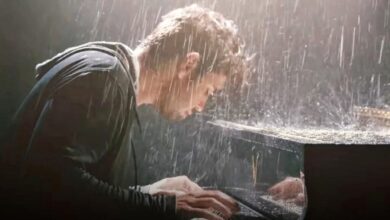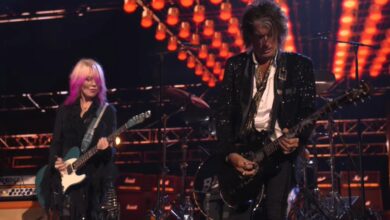Cliff Burton’s Final Night on Stage September 26, 1986
Stockholm was already humming before doors even opened. T-shirts from every Damage, Inc. stop were scattered through subway cars, and outside Solnahallen you could hear fans trading rumors about new riffs, bigger crowds, and a band that seemed to grow more dangerous every month. When the lights finally sank and the taped intro rolled, there was that collective intake of breath you only hear when a room knows it’s about to be leveled. Metallica hit the boards like a freight train, the kind of entrance that turns anticipation into detonation. It felt celebratory, almost triumphant—one of those nights where everything aligns.
Battery was the first fuse to burn down, a mayhem starter that instantly converted the hall into a single organism moving on instinct. James Hetfield’s bark, Lars Ulrich’s skittering fills, and Kirk Hammett’s slicing leads were all there, but what made the floor quake was Cliff Burton’s bass—thick as rebar, musical as a Mellotron, and fully in the pocket. Master of Puppets roared in next like a locomotive rounding a curve at speed, that down-picked blizzard of rhythm translating perfectly to the echoing concrete and metal of an arena built for big sounds.
By For Whom the Bell Tolls, the groove had become gravitational. Burton’s bass lines didn’t simply underpin the riffs; they animated them, giving the song its menacing swagger. The crowd knew every accent and leaned into each dead-stop like a choreographed lurch. When the band slid into Welcome Home (Sanitarium), the temperature in the room seemed to drop—a pocket of eerie calm inside the storm. Hetfield’s clean guitar shimmered, Hammett’s bends felt like razor wire, and Burton threaded countermelodies that made the melancholy bloom. You could sense how dialed-in the quartet had become on this long campaign.
Then came the electricity of Ride the Lightning, a neck-snap turn from hush to havoc, the kind of dynamic whiplash that separates a good set from a great one. The velocity was bracing, but just when you thought the band would ride that momentum unchecked, they downshifted into the evening’s purest Cliff moment: (Anesthesia) Pulling Teeth. The Star-Spangled Banner tease at the front was a wry wink, but what followed was all poetry and peril—fuzz-caked chords, dive-bomb harmonics, and the elastic phrasing that made Burton’s solos feel like small symphonies. It wasn’t indulgence; it was identity.
Whiplash did exactly what it says on the label. It slammed the room back into the pit, a breakneck sprint that reminded you these songs were written to be lived at full speed. The Thing That Should Not Be added a different shade of menace—lurching, ocean-floor heavy, and cinematic in the way the band let the spaces between notes ring like dread bells. Every time Burton locked with Ulrich on those descending figures, the floorboards answered back. If you wanted a blueprint of how Metallica could be both precise and monstrous, those five minutes were a masterclass.
Fade to Black turned the hall into a lantern-lit chorus. Lighters, hands, and voices rose, and the band surfed the wave from plaintive verses to a cathartic cascade. Hammett’s climactic lead felt unmoored from gravity, and Burton’s anchoring presence made the transitions feel inevitable rather than abrupt. Seek & Destroy was the back-to-the-streets rallying cry, Hetfield conducting call-and-response like a punk general, carving the room into left, right, and center factions that still somehow screamed in unison. By Creeping Death, the Solnahallen sounded like a thousand boots stampeding in time—“Die! Die!” echoing off rafters.
The first encore burned quick and mean, but the second encore is where legend and timestamp intersect. The setlist preserved by the band’s archive shows a two-song closer: Blitzkrieg and then the final flamethrower, Fight Fire with Fire. The last song Cliff Burton ever played on a stage was that white-hot thrash sprint, a choice that reads now like a defiant signature—speed, precision, and that feral musicality that made his tone both weapon and melody. It’s a line in the historical ledger that fans have pored over for decades.
Walking out into the Swedish night, fans had that post-show glow—ears buzzing, backs sweaty, voices shredded. The band, meanwhile, loaded into tour buses for the overnight haul south. The Damage, Inc. schedule was relentless: Scandinavia today, Denmark tomorrow, Germany next. It was the kind of calendar that forges steel and steals sleep, a grind every rising band has to navigate. For Metallica, the fall leg was largely their show—no opening slots, just a headlining sprint that doubled as a rite of passage in European halls that loved heaviness.
Sometime before dawn, on a stretch of the E4 north of Ljungby, history turned sharply. The driver later said the bus hit black ice; band members would question that claim for years, recalling a dry road and no glaze underfoot when they searched the shoulder in shock and disbelief. What is documented is the violence of the crash, the sideways skid and roll that ejected Burton from his bunk and pinned him beneath the coach. He was 24. The investigation brought no charges; the explanations never fully soothed.
News traveled the old way—radio, word of mouth, record-shop whispers—and the new way for 1986: bulletin boards, phone trees, and scribbled notes on venue doors. In Stockholm, the same fans who had roared “Die!” the night before were suddenly quiet, congregating in clusters to trade stories and piece together timelines. In the U.S., morning rock stations stumbled through somber programming. Orion became a memorial hymn almost overnight, the instrumental that carried Burton’s fingerprints through every movement now carrying his memory. It’s the song friends and family played as his ashes were scattered.
What made that Stockholm show special, even beyond its place in the chronology, was how completely it captured Metallica’s evolution in real time. You could hear the band stretching the vocabulary of thrash—longer arrangements, dynamic valleys, near-classical themes surfacing under all the distortion. Burton was the bridge between brute force and baroque flourish, plugging a Rickenbacker-raised sensibility into a Marshall-fed juggernaut. The Solnahallen acoustics, all hard surfaces and industrial angles, threw his harmonics into the nosebleeds. Anyone on the back row still felt his pick attack like a tap on the sternum.
There’s a reason setlist archaeologists still comb through the running order and tempos from that night. It reads like an index of mid-’80s Metallica strengths: the whipcrack open, the epics up front rather than hoarded for the encore, the willingness to make a bass solo a centerpiece rather than a bathroom break, and the no-prisoners sprint to the finish. It’s not just nostalgia; it’s a live-action mission statement stamped onto tape and memory. When you line it up against other shows from the tour, Stockholm looks like a pinnacle rather than a mere waypoint.
For the band, those hours onstage were also a culmination of months spent supporting and then outgrowing support slots, moving from undercard to top line through sheer velocity and consistency. The Damage, Inc. tour demanded everything: speed, stamina, and a tolerance for concrete floors and cold mornings. Yet nights like Solnahallen showed the dividends—tighter execution, risk-taking transitions, and a crowd rapport that let Hetfield bark a single syllable and steer the room like a wheel. It was heavy music made communal, not solitary.
The geography of loss has since become a pilgrimage. Fans detour off the E4 to Dörarp, to the memorial stone that marks the place where the tour ended and the next era began. They leave picks, cans, and sharpied notes, small relics that acknowledge a paradox: the band kept climbing, but a cornerstone was fixed in Swedish soil. The site is quiet—just wind through birches and the dull rush of traffic—but it carries a roar you can almost hear if you close your eyes and think of a bass chord blooming into feedback.
Every anniversary, clips and photos from the Stockholm show circulate anew—the sweat-smeared shots under the old logo, the grainy audience cassettes, the setlist screenshots from official archives. One detail is always the same: the closer reads Fight Fire with Fire, a title that looks, in hindsight, like fate’s dark pun. Yet fans don’t dwell on the omen as much as the execution. They talk about the crackle, the last sprint, the sensation that the band emptied the tank. If endings must come, this was one performed at full heart-rate.
Cliff Burton’s legacy is usually summarized in technique—fuzz, wah, chordal shapes, classical motifs—but Stockholm adds a different vibration to the echo. It shows the band using those tools in the field, not the lab, welding sensitivity to shock power in front of thousands of strangers who left as believers. The specialness of that night isn’t only that it was the last, or even that it was great; it’s that it was alive, bristling with risk and reward. In a career defined by loud moments, the Solnahallen show remains one of the loudest, even in silence.
And so the story loops back to that first breath before the lights fell and the tape rolled. Nobody in that arena knew what the morning would bring. They only knew a beloved quartet was stepping into a circle and daring themselves to be faster, heavier, tighter, more. They got all of that—and one more thing that separates regular gigs from the ones you carry around for decades: the feeling you witnessed a hinge in time turning. Years later, if you listen close, you can still hear it creak.





